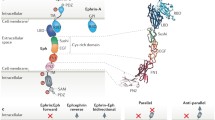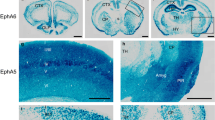Abstract.
The Eph family of tyrosine protein kinase receptors and their cognate ligands, a family of membrane-bound molecules known as ephrins, have been implicated in diverse biological processes, such as axon guidance, the formation of topographic neural projections, axon fasciculation, the regionalization of the central nervous system, and cell migration. The recent generation of mutant mice lacking some of these receptors has made possible the dissection of the role that these molecules play in the development of the mammalian nervous system.
Similar content being viewed by others
Author information
Authors and Affiliations
Additional information
Received: 24 April 1997 / Accepted: 3 June 1997
Rights and permissions
About this article
Cite this article
Frisén, J., Barbacid, M. Genetic analysis of the role of Eph receptors in the development of the mammalian nervous system. Cell Tissue Res 290, 209–215 (1997). https://doi.org/10.1007/s004410050925
Issue Date:
DOI: https://doi.org/10.1007/s004410050925




